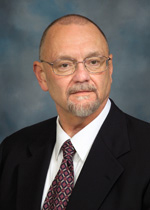 |
Tom Rosenquist, Ph.D. |
At a time of declining funds, including cutbacks at the National Institutes of Health, researchers at the state’s only public academic health science center have grown the enterprise.
“The ability of UNMC researchers to buck the national trend for diminishing grant funding over the past four years has been impressive and is a credit to the success of our scientists,” said Tom Rosenquist, Ph.D., vice chancellor for research.
Since 2003, the actual number of NIH research awards made nationally has declined 21.5 percent, Dr. Rosenquist said.
“During the same period, UNMC researchers have fought for and won an increase of 48 percent in total NIH support,” he said. “It could be argued, therefore, that we have beaten the national index of NIH funding by nearly 70 percent.”
UNMC’s research growth is commendable, said UNMC Chancellor Harold M. Maurer, M.D.
“Our researchers have outstanding studies underway that have gained the support of national funding organizations at a time when securing grants, even for the most promising studies, is difficult,” Dr. Maurer said. “UNMC’s research success will continue to grow with the completion of the new research tower and the recruitment of such stellar faculty as the new College of Pharmacy Dean Courtney Fletcher (Pharm.D.), and cancer researchers Michael Brattain and Drs. Hamid and Vimla Band in the UNMC Eppley Cancer Center.”
Dr. Fletcher, who will join UNMC on Nov. 1 from the University of Colorado Health Sciences Center in Denver, has devoted his research and practice interests toward the clinical pharmacology of antiviral agents. His cumulative federal funding as principal investigator is approximately $9.3 million in direct costs, while the cumulative value of federally funded projects on which Dr. Fletcher has worked as a co-investigator is approximately $40 million.
Michael Brattain, Ph.D., joined UNMC on June 1 as associate director of the Eppley Institute, as well as associate director for basic research at the UNMC Eppley Cancer Center. He was formerly vice president for research and chairman of experimental therapeutics at the Roswell Park Cancer Institute.
Dr. Brattain is the principal investigator on four grants from the National Cancer Institute, totaling more than $4.5 million. Three of these grants have been continuously funded for more than 20 years, and one is an NIH MERIT Award, which is given to the top echelon of researchers funded by NIH. Dr. Brattain’s team is focused on translational research in colon and breast cancers.
Hamid Band, M.D., Ph.D., and Vimla Band, Ph.D., were recently recruited from Northwestern University and will join UNMC on Nov. 1. The Bands are internationally respected breast cancer researchers and are currently principal investigators on six NCI grants, together totaling more than $8 million. Dr. Hamid Band’s primary appointment will be in the Eppley Institute, and Dr. Vimla Band’s primary appointment will be in the UNMC Department of Genetics, Cell Biology and Anatomy.
Between 2006 and 2007, UNMC funding from the NIH has been stable in spite of the continuing, precipitous decline at NIH, Dr. Rosenquist said. At the same time, UNMC’s total research-funding rose by more than $1 million.
“This is a reflection on the ability of our outstanding corps of researchers to diversify their funding portfolios and attract support from new, non-NIH sources while we ride out this difficult period,” he said.
The success of UNMC’s research enterprise is critical because it fuels the clinical and educational missions, Dr. Rosenquist said. During the 21st century (2000-2007), UNMC generated nearly one-half billion dollars total in gross extramural funding ($464 million).
“These are all dollars that otherwise would not have come to Nebraska,” he said.
The total, in fact, is more than 50 percent above inflation.
“This is a substantial value to the campus, university and Nebraska economy,” Dr. Rosenquist said, noting the total would have been $304 million had UNMC just kept up with inflation.
UNMC’s funding success, however, already stands above its peers.
“By experiencing continuing growth we are overcoming a large-scale national trend for academic health sciences centers, many of which show a decline in funding,” Dr. Rosenquist said.
The most recent data available for UNMC’s Board of Regents peer institutions shows that, between fiscal years 2005 and 2006, six of UNMC’s nine peers experienced a loss of NIH support, with an average decline among the six centers of more than 5 percent. The greatest loss was 13 percent. Only one of UNMC’s nine peer institutions was able to match the 5.5 percent growth in NIH funding experienced by UNMC during 2005-2006.
“Bolstering our research emphasis on selected areas, diversifying our funding sources and placing an emphasis on becoming the best place in the country to do biomedical research is paying off,” Dr. Rosenquist said. “Despite the national funding climate, we are within reach of attaining our next goal of $100 million in research funds.”